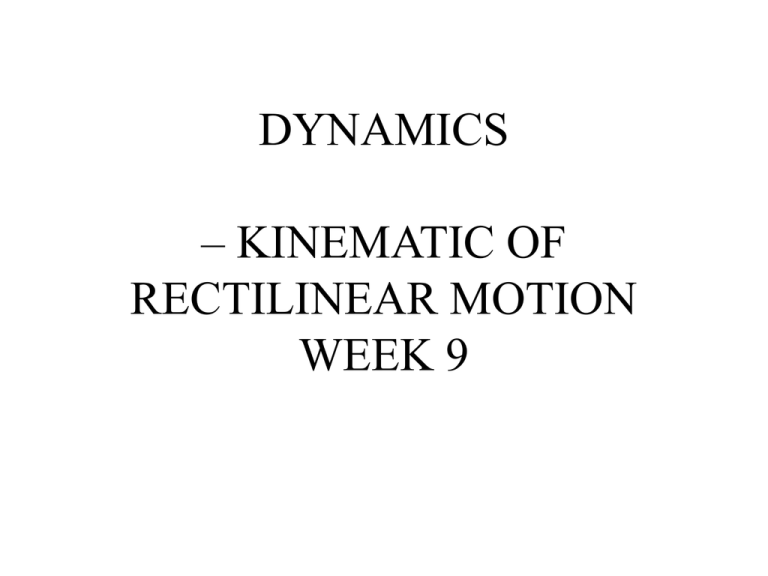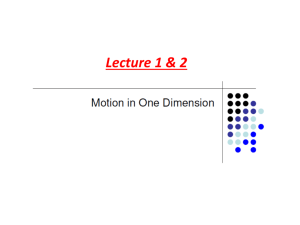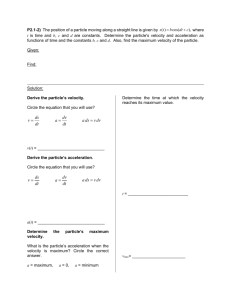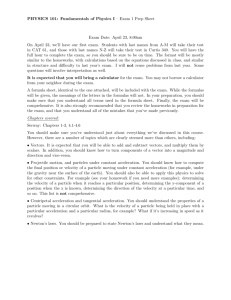eut146 wk9 lect motion
advertisement

DYNAMICS – KINEMATIC OF RECTILINEAR MOTION WEEK 9 INTRODUCTION & RECTILINEAR KINEMATICS: CONTINUOUS MOTION Find the kinematic quantities (position, displacement, velocity, and acceleration) of a particle traveling along a straight path. An Overview of Mechanics Mechanics: The study of how bodies react to forces acting on them. Statics: The study of bodies in equilibrium. Dynamics: 1. Kinematics – concerned with the geometric aspects of motion 2. Kinetics - concerned with the forces causing the motion RECTILINEAR KINEMATICS: CONTINIOUS MOTION (Section 12.2) A particle travels along a straight-line path defined by the coordinate axis s. The position of the particle at any instant, relative to the origin, O, is defined by the position vector r, or the scalar s. Scalar s can be positive or negative. Typical units for r and s are meters (m) or feet (ft). The displacement of the particle is defined as its CHANGE in position. Vector form: r = r’ - r Scalar form: s = s’ - s The total distance traveled by the particle, sT, is a positive scalar that represents the total length of the path over which the particle travels. VELOCITY Velocity is a measure of the rate of change in the position of a particle. It is a vector quantity (it has both magnitude and direction). The magnitude of the velocity is called speed, with units of m/s or ft/s. The average velocity of a particle during a time interval t is vavg = r / t The instantaneous velocity (as t approaches zero) is the time-derivative of position. (smaller and smaller values of t) v equals to dr / dt Speed is the magnitude of velocity: v = ds / dt Average speed is the total distance traveled divided by elapsed time: (vsp)avg = sT / t ACCELERATION Acceleration is the rate of change in the velocity of a particle. It is a vector quantity. Typical units are m/s2 or ft/s2. The instantaneous acceleration is the time derivative of velocity. Vector form: a = dv / dt Scalar form: a = dv / dt = d2s / dt2 Acceleration can be positive (speed increasing) or negative (speed decreasing). The important differential relation involving displacement, velocity and acceleration can be manipulated to get a ds = v dv DEFINITION OF TERMS Position – location of particle at any given time from an origin, unit m or ft The displacement of the particle is defined as its CHANGE in position, unit m or ft. Object is considered a particle as long as the motion is defined by the motion of its mass centre, rotation of the body is neglected Instantaneous Differential Relation v = ds/dt ; …….1 Instantaneous Velocity Instantaneous Acceleration a = dv/dt ……..2 or solve for dt where dt = ds/v and dt = dv/a, will get ds/v = dv/a ……..3 Also from (3), a ds = v dv, therefore: a = v dv/ds DEFINITION OF TERMS Velocity is the RATE of change in the position of a particle. Vector , units of m/s or ft/s. Acceleration is the RATE of change in the velocity of a particle. Vector , units are m/s2 or ft/s2. KINEMATIC RELATIONS for RECTILINEAR MOTION Derived by Differentiating position to get velocity & acceleration. v = ds/dt ; a = dv/dt or a = v dv/ds • Integrate acceleration for velocity and position. Velocity: v t dv = a dt vo o or dt = ds/v Position: v s v dv = a ds s t ds = v dt vo so so o • Note that so and vo represent the initial position and velocity of the particle at t = 0.






